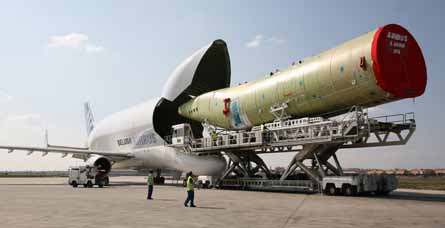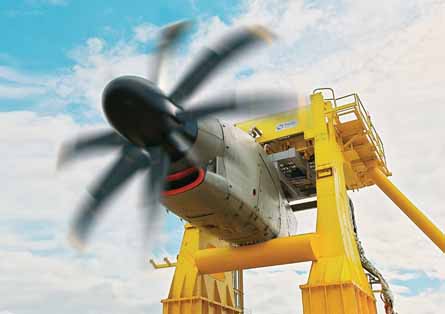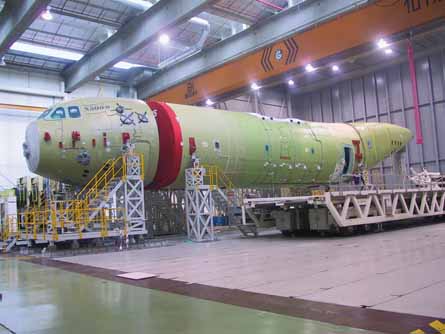Airbus Military is upbeat after a difficult six months in the life of its A400M, but will Europe's giant airlifter keep its flight schedule?
While Airbus's flagship A380 will dominate the skies at Le Bourget this year, the company's first dedicated military transport aircraft - the A400M - will be maintaining a much lower profile, as the project battles to avoid the development woes that have previously afflicted its commercial stablemate.
Launched in May 2003 with the signature of a 180-aircraft development and production contract by Europe's OCCAR procurement agency acting on behalf of seven partner nations, the A400M is publicly declared as being on track to achieve its first flight in the first quarter of 2008, albeit later than a previous goal of next January. But with the project's aggressive timescale leaving little room for error, Airbus Military is assessing the possible implications of two setbacks that have affected its development activities over the last six months.
|
|---|
Major A400M sub- assemblies have been arriving at Getafe this year from all over Europe in Beluga transports |
Initiated in response to an internal audit that warned of risk in the final assembly of the A400M in Seville, Spain, and in completing the development of undisclosed key mission equipment, the choice to delay final assembly activities by at least three months from late March has been described as a risk-reduction measure. Decisions on whether to launch build work from late this month have yet to be made, with these to be informed by the completion of a static test airframe now being assembled at EADS Casa's Getafe site near Madrid. With the first A400M due to fly within the next nine months, any further delay in opening the final assembly line in Seville could have a knock-on effect on the programme's brief flight-test phase, as the first production delivery remains set for the fourth quarter of 2009.
Proving trials of one of the A400M's most critical technologies - its Europrop International TP400-D6 turboprop engine - have also slipped to the right, with a prototype system originally scheduled to have been airborne on a flying testbed in the first quarter of this year. The UK's Marshall Aerospace recently installed the engine pylon for the TP400 on the modified Lockheed Martin C-130 in preparation for the test phase, and is now expected to receive the powerplant next month.
Comprising industrial partners ITP, MTU, Rolls-Royce and Snecma, Europrop had by early last month amassed over 300 test hours with the TP400, which with an output of 11,000shp (8,200kW) is the most powerful turboprop engine ever developed in the West. First run at Istres in France with its Ratier-Figeac eight-bladed propeller and Avio gearbox in February 2006, a second engine is being run at Morón airbase near Seville as an open-air clearance test of its endurance and noise characteristics. Development of the three-shaft design began in 2004 and at least 12 engines will be produced in the initial project phase.
Taking shape
Despite the concerns over the A400M's final assembly, the programme's first airframe - a static test example dubbed "Aircraft 5000" - is now rapidly taking shape at Getafe. Major subassemblies for the aircraft have been arriving at the site since earlier this year from locations across Europe using Airbus A300-600ST Beluga transports, with these including its fuselage barrel from Bremen, Germany and nose section from the St Nazaire facility of Airbus France. Produced at Airbus UK's Filton site, the aircraft's composite wing is being mated with its centre wing box from Airbus France in Seville, and will shortly be transported to Getafe by road for integration with the static test asset. The airframe will be put through a one-year campaign on its completion, and will eventually be tested to destruction in support of the main development and production effort.
|
|---|
Delays have set back flight trials of the Europrop TP400-D6 turboprop, but the first A400M airframe is now taking shape at Getafe
|
Airbus Military's current orderbook - which on top of the core European purchase also includes four aircraft for Malaysia and eight for South Africa - will cover production activities until 2021, with deliveries to hit 30 a year at peak rate. The French air force is to take the first aircraft in October 2009, with South Africa to receive its first in 2010. Fifty aircraft will have been delivered by 2011 and more than 100 by 2013, says senior vice-president communications Richard Thompson.
However, EADS North America recently confirmed that it will be unable to offer the A400M to meet a lucrative US Air Force requirement to replace special-operations HC-130N/P tankers and MC-130E/P transports from 2011, due to the delivery commitments already made to its existing customers (Flight International, 22-28 May). Further delays to the development programme would risk damaging its ability to swiftly capitalise on the possible end to production of Boeing's larger C-17 from August 2009, and open the door to additional sales of the C-130J and potentially also of Embraer's planned C-390 airlifter.
But with such types offering a payload capacity of only half that of the A400M's 37t load and lacking its ability to transport outsized cargo, Airbus Military believes such types are complementary rather than competitive. If the company is to achieve its vision of selling a further 208 A400Ms to 33 possible customer nations over the next 20 years, then it must hope to have made the right assessment of the potential threat from smaller airframes.
Refuelling progress
In a more positive sign for the European project, development of one of its potentially major sales points is advancing to plan, with 905E-series hose and drogue refuelling pods having recently been integrated with the Royal Australian Air Force's first Airbus A330 multirole tanker-transport after completing successful trials on an A310 testbed. Developed by Cobham subsidiary Flight Refuelling, the design is highly common with the equipment selected in December 2005 to equip 29 A400Ms for France, Germany and Spain, which are to acquire a combined 58 908E wing pods. The UK company is also to supply 11 centreline hose drum refuelling units for France and Germany under combined orders worth more then €85 million ($114 million). First test hardware for the 908E system will be completed this year.
The management of the A400M programme, along with the A330 MRTT effort and other Airbus initiatives, is meanwhile to come under new stewardship from 1 July, with EADS Casa's current head of Airbus derivatives Carlos Suárez to take the helm at EADS's Military Transport Aircraft division, replacing Francisco Fernández Sainz, who also now holds the post of chairman for Airbus Military SL.
If all goes to plan with final assembly and TP400 flight testing over the latter part of this year, Europe's first A400M could be the star attraction at the ILA air show in Berlin next April. The event represents a worthy target for Airbus Military, with the German air force holding the status of its lead customer, with 60 aircraft on order and an expectation to receive its first transport in August 2010.
Source: Flight International



















